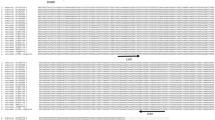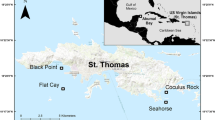Abstract
Mantis shrimp has become commercially valuable in many countries, while the commercially aquaculture still unsuccessful. The stable supply of the species-specific markers for precise identification can play a key role of foods authentication as well as restoring/enhancing mantis shrimp stocks in future. The aim of this research was to identify species-specific markers for Squillid and Harpiosquillid mantis shrimp taxa using Amplified fragment length polymorphism-Single strand conformation polymorphism (AFLP-SSCP) approaches. Selective amplification would be substituted as a total of 40 primer combinations was performed using either three-base (i.e., EcoRI+3 and MseI+3 in 20 primer combinations) or two-base (i.e., EcoRI+2 and MseI+2 in 20 primer combinations) selective primers. These had been size-fractionated via 6% denaturing polyacrylamide gel electrophoresis, ten AFLP fragments exhibiting species or genus-specific characteristics were cloned, sequenced, and GenBank interrogated. A primer pair was designed and their specificity was tested versus the genomic DNA of various species. Results show that the primer E+2-13/M+2-13Hr158 generated PCR products for just H. harpax, while E+3-14/M+3-2HhHr151 and E+2-13/M+2-13Hh150 generated PCR products for both H. harpax and H. raphidea and not others (i.e., M. nepa, O. oratoria, and E. woodmasoni). SSCP was then applied in order to differentiate between H. harpax and H. raphidea. These SSCP results indicate that species can be differentiated based on polymorphic fragment nucleotides. Indeed, primers E+2-13/M+2-13Hr158, E+3-14/M+3-2HhHr151, and E+2-13/M+2-13Hh150 were all successfully confirmed as present in processed mantis shrimp samples (i.e., saline-preserved and heat-dried). These results provide new species-specific markers for mantis shrimp identification.




Similar content being viewed by others
References
Manning RB (1980) The superfamilies, families, and genera of recent stomatopod Crustacea, with diagnoses of six new families. Proc Biol Soc Wash 93:362–372
Ahyong ST (2001) Revision of the Australian stomatopod Crustacea. Rec Aust Mus 26:8–193
James DB, Thirumilu P (1993) Population dynamics of Oratosquilla nepa in the trawling grounds off Madras. J Mar Biol Assoc India 35:135–140
Hiransuchalert R, Bukbun W, Noppamas D, Kongsiri J (2015) Some biological aspects of the smalleyed squillid mantis shrimp Miyakea nepa (Latreille, 1828) in Laemsing, Chanthaburi province. Khon Kaen Agric J 43:29–38
Kodama K, Yamakawa T, Shimizu T, Aoki I (2005) Age estimation of the wild population of Japanese mantis shrimp Oratosquilla oratoria (Crustacea: Stomatopoda) in Tokyo Bay, Japan, using lipofuscin as an age marker. Fish Sci 71:141–150
Maynou F, Abelló P, Sartor P (2005) A review of the fisheries biology of the mantis shrimp, Squilla mantis (L., 1758) (Stomatopoda, Squillidae) in the Mediterranean. Crustaceana 77:1081–1099
Jose HMPM, Murugesan P, Arumugam M, Kumar KM (2014) Isolation and characterization of acid and pepsin—solubilised collagen from the muscle of mantis shrimp (Oratosquilla Nepa). Int J Pharm Pharm Sci 6:1–4
Carpenter KE, Niem VH (1998) FAO species identification guide for fishery purposes: the living marine resources of the Western Central Pacific volume 2 cephalopods, crustaceans, holothurians and sharks. FAO, Rome
Lockley AK, Bardsley RG (2000) DNA-based methods for food authentication. Trends Food Sci Technol 11:67–77
Pascoal A, Barros-Velazquez J, Cepeda A, Gallardo MJ, Calo-Mata P (2008) A survey of the authenticity of prawn and shrimp species in commercial food products by PCR-RFLP analysis of a 16S rRNA/tRNAVal mitochondrial region. Food Chem 109:638–646
Cao J, Yu B, Ma L, Zheng Q, Zhao X, Xu J (2011) Detection of shrimp-derived components in food by real-time fluorescent PCR. J Food Prot 74:1776–1781
Miller AD, Austin CM (2016) The complete mitochondrial genome of the mantid shrimp Harpiosquilla harpax, and a phylogenetic investigation of the Decapoda using mitochondrial sequences. Mol Phylogenet Evol 38:565–574
Weder JK, Rehbein H, Kaiser J (2001) On the specificity of tuna-directed primers in PCR-SSCP analysis of fish and meat. Eur Food Res Technol 213:139–144
Khamnamtong B, Klinbunga S, Menasveta P (2005) Species identification of five penaeid shrimps using PCR-RFLP and SSCP analyses of 16S ribosomal DNA. J Biochem Mol Biol 38:491–499
Vos P, Hogers R, Bleeker M, Reijans M, van de Lee T, Hornes M, Frijters A, Pot J, Peleman J, Kuiper M (1995) AFLP: a new technique for DNA fingerprinting. Nucleic Acids Res 23:4407–4414
Liu ZJ, Cordes JF (2004) DNA marker technologies and their applications in aquaculture genetics. Aquaculture 238:1–37
Maldini M, Marzano FN, Fortes G, Papa R, Gandolfi G (2006) Fish and seafood traceability based on AFLP markers: elaboration of a species database. Aquaculture 261:487–494
Wang ZY, Tsoi KH, Chu KH (2004) Applications of AFLP technology in genetic and phylogenetic analysis of penaeid shrimp. Biochem Syst Ecol 32:399–440
Department of Fisheries Products (2014) Fishery product science and technology. KU Book Center, Bangkok
Sambrook J, Russell DW (2001) Molecular cloning: a laboratory manual. Cold Spring Harbor Laboratory Press, New York
Michelmore RW, Paran I, Kesseli RV (1991) Identification of markers linked to disease resistance genes by bulk segregant analysis: a rapid method to detect markers in specific genomic regions using segregating populations. Proc Natl Acad Sci USA 88:9828–9832
Griffiths R, Orr K (1999) The use of amplified fragment length polymorphism (AFLP) in the isolation of sex-specific markers. Mol Ecol 8:671–674
Rehbein H, Mackie IM, Pryde S, Gonzales-Sotelo C, Medina I, Perez-Martin R, Quinteiro J, Rey-Mendez M (1999) Fish species identification in canned tuna by PCR-SSCP: validation by a collaborative study and investigation of intra-species variability of the DNA-patterns. Food Chem 64:263–268
Klinbunga S, Thamniemdee N, Yuvanatemiya V, Khetpu K, Khamnamtong B, Menasveta P (2010) Species identification of the blue swimming crab Portunus pelagicus in Thai waters using mtDNA and RAPD-derived SCAR markers. Aquaculture 308:39–46
Barber P, Boyce SL (2006) Estimating diversity of Indo-Pacific coral reef stomatopods through DNA barcoding of stomatopod larvae. Proc R Soc B 273:2053–2061
Tang RWK, Yau C, Ng WC (2010) Identification of stomatopod larvae (Crustacea: Stomatopoda) from Hong Kong waters using DNA barcodes. Mol Ecol Resour 10:439–448
Buermans HPJ, den Dunnen JT (2014) Next generation sequencing technology: advances and applications. Biochim Biophys Acta 1842:1932–1941
Sodsee N, Wongphayak S, Kondo H, Hirono I, Hiransuchalert R (2018) A preliminary study on differential gene expression in hemocyte of the mantis shrimp Harpiosquilla raphidea by next generation sequencing technique. J Appl Sci 17:27–36
Grabherr MG, Haas BJ, Yassour M, Levin JZ, Thompson DA, Amit I et al (2011) Full length transcriptome assembly from RNA-Seq data without a reference genome. Nat Biot 29:644–652
Klinbunga S, Amparyup P, Leelatanawit R, Aoki T, Hirono I, Tassanakajon A, Jarayabhand P, Menasveta P (2004) Species identification of the tropical abalone (Haliotis asinina, Haliotis ovina and Haliotis varia) in Thailand using RAPD and SCAR markers. J Biochem Mol Biol 37:213–222
Klinbunga S, Khamnamtong N, Tassanakajon A, Puanglarp N, Jarayabhand P, Yoosukh W (2003) Molecular genetic tools for three commercial cultured oysters (Crassostrea belcheri, C. iredalei and Saccostrea cucullata) in Thailand. Mar Biot 5:27–36
Klinbunga S, Boonyapakdee A, Pratoomchat B (2000) Genetic diversity and species diagnostic markers of mud crab (Genus Scylla) in eastern Thailand determined by RAPD analysis. Mar Biot 2:180–187
Acknowledgements
This work was supported by grants (to RH) from Higher Education Research Promotion (HERP) and National Research University Project of Thailand, Office of the Higher Education Commission (code 1/2558 Burapha University).
Funding
This work was supported by grants (to RH) from Higher Education Research Promotion (HERP) and National Research University Project of Thailand, Office of the Higher Education Commission (code 1/2558 Burapha University).
Author information
Authors and Affiliations
Corresponding author
Ethics declarations
Conflict of interest
Authors declare no potential conflicts of interest with respect to the research, authorship, and/or publication of this article.
Ethical approval
The main research project researcher of this study was approved for animal ethics by Institute of animals for scientific purposes development (IAD), THAILAND (Animal used license U1-03631-2559, National Level). This research was approved for biosafety by the Institutional Biosafety Committee of Burapha University Thailand.
Additional information
Publisher's Note
Springer Nature remains neutral with regard to jurisdictional claims in published maps and institutional affiliations.
Electronic supplementary material
Below is the link to the electronic supplementary material.
Rights and permissions
About this article
Cite this article
Hiransuchalert, R., Tongiang, B., Sae-chua, C. et al. The development of species-specific AFLP-derived SCAR and SSCP markers to identify mantis shrimp species. Mol Biol Rep 47, 6807–6816 (2020). https://doi.org/10.1007/s11033-020-05738-3
Received:
Accepted:
Published:
Issue Date:
DOI: https://doi.org/10.1007/s11033-020-05738-3




